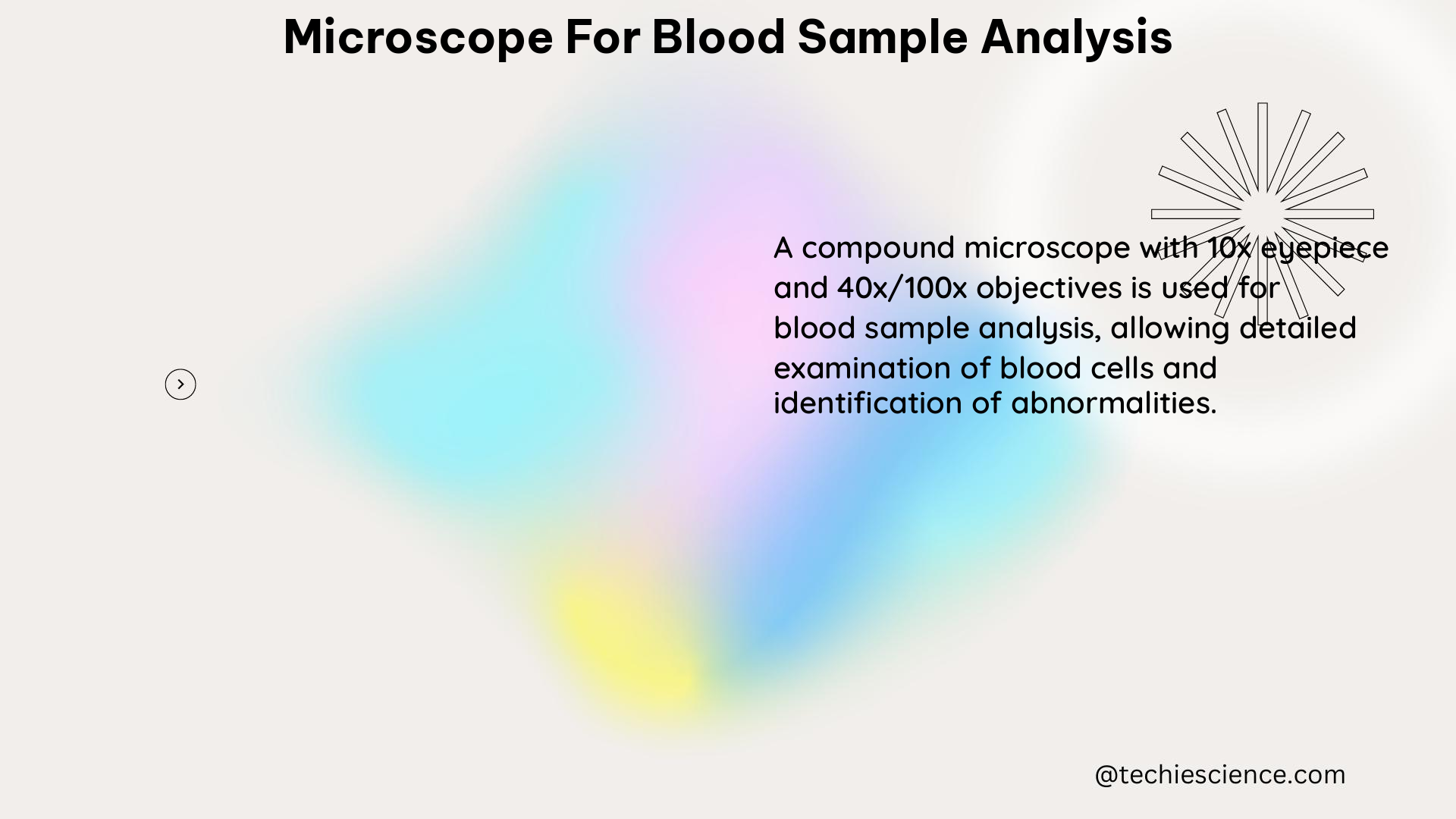Microscope for blood sample analysis is a crucial tool in medical diagnostics, enabling the examination of blood cells and their morphological parameters. This comprehensive guide delves into the technical specifications, physics principles, and applications of microscopes used for blood sample analysis, providing a detailed and informative resource for physics students and medical professionals alike.
Technical Specifications of Microscopes for Blood Sample Analysis
The microscope used for blood sample analysis should possess several key technical specifications to ensure optimal performance and accurate results. One of the most important factors is the numerical aperture (NA) of the objective lens. The NA determines the resolution and light-gathering ability of the microscope, with higher NA values providing better resolution and contrast.
Typically, the NA for microscopes used in blood sample analysis ranges from 0.1 to 1.4, with higher values offering superior performance. For instance, the wDPM (wide-field digital holographic microscopy) system discussed in the references uses a high-NA objective lens to capture detailed information about red blood cells.
Another important technical specification is the magnification of the microscope. While the exact magnification required may vary depending on the specific application, blood sample analysis often requires high magnification to visualize and analyze the intricate details of blood cells. Commonly, microscopes used for this purpose have magnification ranges from 40x to 100x or even higher.
Physics Principles Underlying Microscopes for Blood Sample Analysis

The wDPM system mentioned in the references is based on the principles of quantitative phase imaging (QPI), a technique that measures the phase shift of light as it passes through a sample. This method provides nanometer-scale information about the cell profile, enabling highly sensitive measurement of volume and morphology.
QPI is an interferometric technique that relies on the principles of wave optics, specifically the interaction of light waves with the sample’s refractive index distribution. The phase shift (Δφ) in QPI can be calculated using the formula:
Δφ = (2π/λ) × Δn × t
Where:
– λ is the wavelength of light
– Δn is the difference in refractive index between the sample and the surrounding medium
– t is the thickness of the sample
This formula highlights the relationship between the phase shift and the sample’s refractive index and thickness, which are critical parameters for blood sample analysis.
Measurable Data and Morphological Parameters
The wDPM system discussed in the references can measure various morphological parameters of red blood cells, including:
- Volume
- Minimum cylindrical diameter
- Equivalent diameter
- Sphericity
These parameters are crucial for diagnosing hematological disorders, such as macrocytic and microcytic anemia, which are characterized by changes in red blood cell size and shape.
The wDPM system can analyze a thousand cells in less than 5 minutes, providing arrays of numerical data (text files) as output. This data can be easily transmitted wirelessly over the cellular network, facilitating remote analysis and diagnosis.
Physics Formulas and Numerical Problems
To better understand the principles behind the wDPM system, let’s consider a numerical problem:
Suppose a red blood cell has a diameter of 8 μm and a refractive index of 1.39. If the wDPM system uses light with a wavelength of 550 nm, calculate the phase shift (Δφ) if the cell thickness increases by 0.2 μm.
Given:
– λ = 550 nm
– Δn = 0.39 (refractive index difference between the cell and the surrounding medium)
– t = 0.2 μm (increase in cell thickness)
Substituting the values in the formula:
Δφ = (2π/550 nm) × 0.39 × 0.2 μm ≈ 0.07 radians
This calculation demonstrates how the phase shift is directly related to the sample’s refractive index and thickness, which are crucial parameters for blood sample analysis.
Figures and Data Points
The wDPM system discussed in the references provides detailed figures and data points illustrating its performance in blood testing. These visual aids help understand the system’s capabilities and limitations in measuring various morphological parameters of red blood cells.
For example, the figures may include scatter plots, histograms, or heatmaps that visualize the distribution of red blood cell parameters, such as volume, diameter, and sphericity. The data points can provide quantitative information about the accuracy, precision, and repeatability of the measurements, as well as the system’s ability to differentiate between normal and abnormal blood cells.
By analyzing these figures and data points, physics students and medical professionals can gain a deeper understanding of the technical aspects of the wDPM system and its potential applications in hematological diagnostics.
Conclusion
Microscope for blood sample analysis is a complex and multifaceted field that combines advanced physics principles, high-precision optics, and sophisticated image processing techniques. The wDPM system discussed in this guide is an excellent example of a quantitative phase imaging method that provides nanometer-scale information about red blood cells, enabling the measurement of crucial morphological parameters for diagnosing hematological disorders.
By understanding the technical specifications, physics principles, and measurable data associated with microscopes for blood sample analysis, physics students and medical professionals can better appreciate the role of these instruments in modern medical diagnostics and research.
References
- Quantitative phase imaging techniques for the study of cell pathophysiology: from principles to applications
- Automated analysis of red blood cell morphology using wide-field digital holographic microscopy
- Wide-field digital holographic microscopy for high-throughput analysis of red blood cell morphological parameters

The lambdageeks.com Core SME Team is a group of experienced subject matter experts from diverse scientific and technical fields including Physics, Chemistry, Technology,Electronics & Electrical Engineering, Automotive, Mechanical Engineering. Our team collaborates to create high-quality, well-researched articles on a wide range of science and technology topics for the lambdageeks.com website.
All Our Senior SME are having more than 7 Years of experience in the respective fields . They are either Working Industry Professionals or assocaited With different Universities. Refer Our Authors Page to get to know About our Core SMEs.